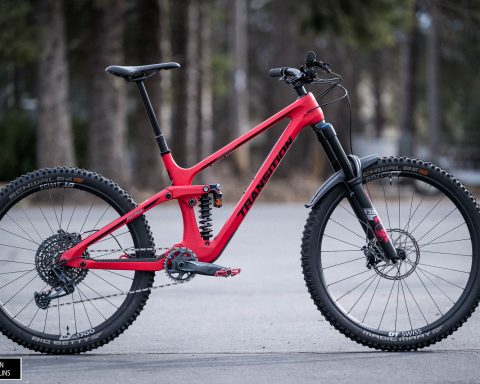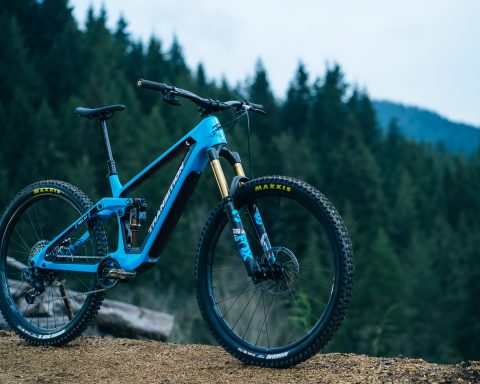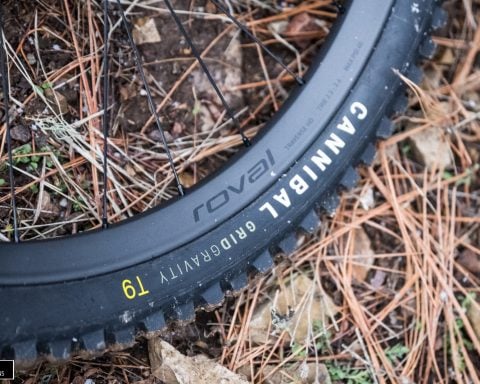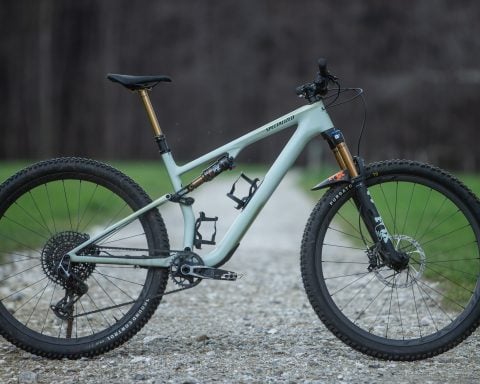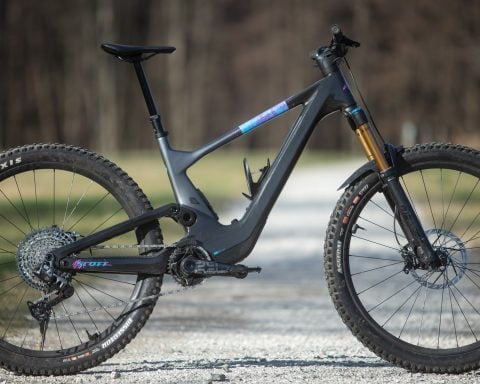In July I attended the launch of a new bike which I’ve given very high praise in its past iteration – the Transition Sentinel. Now in its third time around, the already highly versatile rig boasts updated geometry and improved kinematics as well as downtube storage, fully internal cable routing and a flip chip. I managed to get a few solid rides in on the new bike deep in the middle of Summer. Luckily, that coincided with a one-off rain storm that revitalized the local soil during an atypically dry Summer in Bellingham, Washington. The trails I rode included all manner of diverse terrain, which provided fertile ground for getting a solid grasp of what this bike is all about in rather short order. With that said, this is by no means a full and comprehensive long term review and I’ll focus less on the nitty gritty details in terms of spec, but more on the inherent attributes of the frame…
On first glance the new Sentinel doesn’t seem like a major departure from its prior version and that’s because it isn’t. Rather, it features a plethora of subtle refinements that build on its heritage. Tasked as Transition’s all rounder it features 160mm of front travel and 150mm of rear travel. Like the Sentinel V2, it can still be long stroked to 160mm for heavier duty tasks, and the bike is cleared for usage with a 170mm fork. While I’m not sure if that would be the best use case for this model, more options are better than less. Regardless, Transition emphasized the fact that this bike has a more focused and sprightlier disposition aimed specifically at the mid-duty or “one and done bike” category that we once called “All Mountain”. Lastly, the V3 Sentinel’s high/low flip chip isn’t meant for geometry tweaks, but rather to switch between a mixed wheel setup or full 29″. I’ll parse out the finer points deeper into the writeup, so read on for the full scoop…
Details
- Six sizes: XS-XXL
- 29” Wheels S-XXL and mixed wheel compatible (dual 27.5 on XS)
- Size specific Chainstays (XS 436, SM/MD 442, LG/X-L/XXL 448)
- Carbon and Aluminum frame options
- 160mm travel front, 150mm travel rear (up to 160mm)
- High/Low flip chip for MX or 29″ (only 29″ complete bikes available)
- “Boom Box” downtube storage
- Main pivot mud guard
- Internal cable/hose routing
The Sentinel’s flip chip sits in the lower shock eyelet for easy access and swaps via a 5mm allen key. That general area of the bike has been refined to collect less mud and water as well. The Sentinel V3 also sees a slightly shorter 60mm shock stroke (compared to 62.5mm for V2) and an updated linkage for improved clearance so that if you do choose to bump up to a 65mm stroke rear shock to achieve 160mm rear travel, there are no issues.
A nice new detail is the addition of a tidy little mud guard that helps protect the main pivot from excessive mud/water/pebble intrusion.
A look from the rear 3/4 of the bike reveals a familiar industrial design, however you can get a better idea of how the down tube has been enlarged to accommodate the internal storage. The single lever on the door is super easy to actuate. Keen eyes may also notice a beefed up and improved chainstay protector.
I’ll get into it more further down, but my first ride on RockShox’s new Linear XL can has me very impressed. It could mainly be a kinematics thing, but the shock felt really, really good on trail and I’d be curious to try one on my personal bike at some point.
Last but not least, Transition has finally moved away from an external rear brake routing. With that in mind the access ports which the cables/hoses pass into the frame are roomy and tidy, making for easier maintenance than many systems out there.
Geometry
Compared to the Sentinel V2 there are some slight changes to the geometry which all add up. My size large has a 4mm longer reach and 8mm longer chainstays, putting the rider a bit more centered between the front and rear center of the bike. On the angle side, a .4º steeper head tube angle makes for snappier cornering while a 1.4º steeper seat tube angle puts you further forward to pair well with the increased reach numbers. Lastly, most of the bikes see an ever so slightly (~3mm) taller bottom bracket height, which tracks with the bike’s stated intention of being equally competent at both climbing and descending.
29″/High
Mixed wheel/Low
While at this point in time Transition has not finalized an official geometry chart for the mixed wheel/low setting they did pass the following information on. Reach shrinks by 4mm per size, BB height is lower by 6mm. Head tube and seat tube angles are .4º slacker. Chainstays are 2mm shorter. This goes for all sizes with the exception of the stock 27.5 front and rear XS.
Pricing (USD)
Alloy Deore – $3,299.00
Alloy XT – $4,499.00
Carbon Fiber Deore – $4,899.00
Carbon Fiber XT – $6,199.00
Carbon Fiber XO AXS – $7,899.00
Alloy Frameset – $2,199.00
Carbon Fiber Frameset – $3,399.00
On the trail
After a fairly quick drive to the coast I arrived at Transition’s Outpost in Bellingham, Washington. If you haven’t been to Bellingham, it’s arguably the best place to ride in the US. It’s safe to call it the closest thing we’ll get to B.C. style riding – which isn’t surprising given its proximity. And if you have been to Bellingham, but haven’t been to the Transition Outpost, definitely put it on your list. It’s a lovely hub in the nexus of multiple trail systems staffed with friendly and helpful folks who are eager to share intel on the local trails, tune up your bike and share a beer or coffee. Transition reinvests in their local community more than most bike brands out there and it shows. They put a great deal of money and elbow grease into getting trails built for every level of riding ability and age group. That’s definitely worth the tip of a hat…
After setting my sag and contact points it was off to the trails. Out of the gate I noticed that while the new Sentinel felt familiar, it was substantially more effortless when it came to last second micro-adjustments and late pops to get over awkward obstacles and stubborn, offbeat sections of trail. Don’t get me wrong, the last bike – like most of Transition’s bikes – had quite a bit of pop baked in. However, where I would have needed to load the suspension to yank over a rock, a root or get to a backside, the updated suspension didn’t require as much input. The initial travel was more supportive, yet somehow managed to suffer no downsides in its off-the-top suppleness, traction or mid-stroke compliance. It assisted more with the late blips and yanks and felt more effortless, thus saving energy. In short, I didn’t have to be as cerebral or intentional while riding it. Quick little pickups allowed me to intuitively place the bike where I wanted to put it. It’s a strange feeling to attempt to convey in verbal terms, but basically the bike immediately felt like a second skin.
Other aspects of note were the slightly higher BB and longer chainstays. As the Sentinel has shifted from being Transition’s longest travel 29″ bike (V1) to this new version as a “do it all” bike, there is now an increased emphasis on making it a more competent climber. In this regard the slightly taller bottom bracket combined with a kinematic that keeps you sitting in a slightly higher part of the travel means you’ve got improved pedal clearance on nastier, more technical climbs. Regarding the drawn out chainstays, I do think they added to the bike’s stability at speed as well as providing a more centered position on the bike. While I didn’t feel any noticeable setbacks in terms of cornering prowess, that did come with some minor tradeoffs in terms of how easy it was to manual the bike. With that in mind, in the mixed wheel configuration the chainstays will naturally shorten up a bit as you switch to the high position and the smaller rear wheel will assist with manualing as well if you’re into that kind of thing. The decision to go mullet or 29″ likely comes down to rider preference and local terrain.
So while a great many aspects have been updated on the Sentinel, the kinematics and trail feel was my main takeaway – it was certainly the most striking change in a sea of subtleties. Personally, I do have to wonder if some credit is due to the new RockShox Super Deluxe rear shock with the Linear XL air can. On that note, Transition was quick to point out that they were emphatic about tuning the bike in a way that it lands right in the middle of the tuning range for volume reducers both on the positive and negative spring side, leaving the end consumer with loads of options. While I had no major gripes about the geometry numbers on the last bike the refinements on offer here also contributed to its sprightlier, more intuitive nature. On the bigger climbs it also felt a bit more upright and efficient, sitting higher in the travel. As someone who often does utilize the lockout lever, I did not reach for it once, despite some very torturous climbs on our second day. As a sidebar, I found it interesting that Transition made the rather unconventional decision to spec RockShox suspension with Shimano drivetrains and Fox suspension with SRAM drivetrains. While my time was spent solely on the former, I am curious to see how the latter would fare as well, but my colleague who was riding a Fox/SRAM version also seemed to have very high praise of the shock tune and kinematics on his bike.
For the bulk of my rides I didn’t need make use of the internal storage but I can say that it is logically laid out and it’s worth giving Transition a nod for designing a system that decouples the bottle cage from the storage hatch. Although I have never given it too much thought, it is a little annoying having to fumble with a somewhat top heavy cover that has a water bottle attached to it. Keeping those bits separate is a more logical approach, however I do think that it may make it slightly harder to reach some bits and pieces that get jammed way up high in the downtube – although gravity is on the end user’s side when it comes to removing said bits.
Overall
In most of my reviews I tend to put a bow on things by assessing a bike’s value, regardless of the spec level that I ride. Much like the last time I tested a Sentinel, Transition deserves high praise in this arena once again. The model I tested had no glaring low points and a wisely chosen spec that puts it in a very competitive position at $6,199. It’s worth noting that on the more affordable end of the spectrum the aluminum offerings boast an incredible value, should all of the above praise seem tempting but you don’t see the need for a fancier carbon fiber frame. Just remember that the AL models do not have the internal downtube storage. On the other end of the price scale, while it is an expensive bike in the grand scheme of things the Carbon Fiber XO AXS ($7,899.00) offers a really nice spec that comes in at a much lower cost than many other flagship models from boutique brands.
As far as a summary on the new Sentinel, I am extremely impressed by my first impressions and I’m hard pressed to pick apart a single low point. While many things appeal in terms of the bike’s features, it was the improved ride quality – which stems from perfectly refined kinematics and razor sharp geometry – that really won me over. It’s also worth pointing out that the support on tap from Transition is excellent. They offer a lifetime warranty and it’s very easy to get wear parts, hardware and bearings directly on their website. In recent months, the mid-travel, do it all bike category has grown with fresh updates to other appealing bikes like the Santa Cruz Hightower / Bronson, plus the new Specialized Stumpjumper. To be clear, I haven’t ridden those bikes personally but our Italian editors have heaped praise on them. One note on wheel layout that’s worth pointing out…with Santa Cruz you’ll have to choose between the two models and with the Specialized you’ll have to buy an additional shock link if you want to go back and forth between mullet and 29″. With the Sentinel you can buy a 27.5″ wheel and only need a single 5mm allen key to swap between setups, while also having the bonus of a backup rear wheel. At the end of the day, if you’re in the market for a highly versatile MTB that can do nearly everything and do it well, it would be foolish not to take a second look at the new Sentinel.
Photos: Skye Schillhammer














